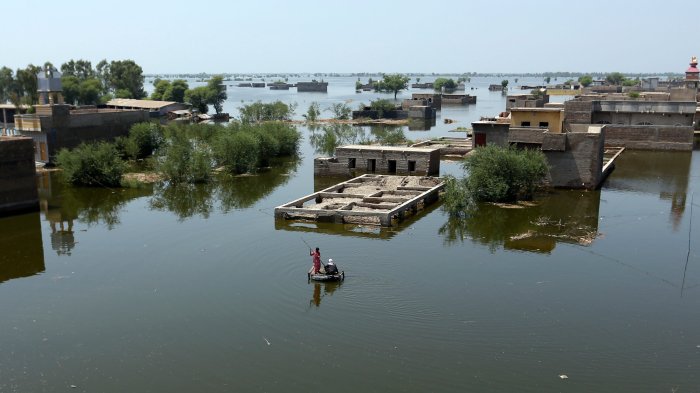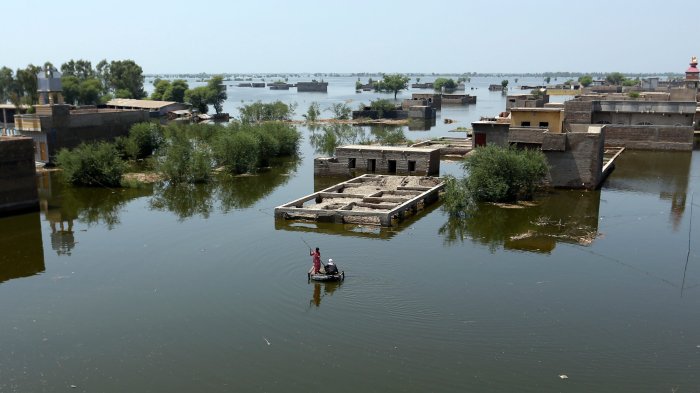
Pakistans Floods: A Climate Catastrophe with Political Roots
The flooding in pakistan is a climate catastrophe with political roots – Pakistan’s Floods: A Climate Catastrophe with Political Roots. The recent catastrophic flooding in Pakistan has laid bare a stark reality: the intersection of climate change and political negligence. This devastating event has not only caused immense human suffering and widespread destruction but has also highlighted the urgent need for a global response to address the complex interplay of environmental factors and political shortcomings.
The scale of the disaster is staggering. Millions of people have been displaced, their homes and livelihoods washed away by relentless monsoon rains. The economic impact is equally profound, with agriculture, infrastructure, and essential services severely damaged. This catastrophe underscores the vulnerability of Pakistan to climate change and the need for a more proactive approach to disaster preparedness.
The Scale and Impact of the Flooding

The devastating floods that ravaged Pakistan in 2022 were a stark reminder of the devastating consequences of climate change. The scale of the disaster was unprecedented, affecting millions of people and causing widespread destruction across the country.
Extent of the Flooding
The flooding, triggered by heavy monsoon rains and glacial melt, affected over 70% of Pakistan, impacting 33 million people. The provinces of Sindh, Balochistan, and Khyber Pakhtunkhwa were particularly hard hit. Millions of people were displaced from their homes, seeking refuge in temporary shelters or with relatives.
The flooding inundated vast swathes of land, turning fertile fields into lakes and destroying homes, infrastructure, and livelihoods.
Damage to Infrastructure, Agriculture, and Livelihoods
The floods caused widespread damage to infrastructure, including roads, bridges, and communication networks, severely disrupting access to essential services and humanitarian aid. The agricultural sector, a vital source of income for millions of Pakistanis, suffered significant losses. Standing crops were washed away, livestock perished, and irrigation systems were destroyed, leading to food insecurity and economic hardship.
The floods also impacted industries, businesses, and transportation networks, further exacerbating the economic crisis.
Casualties and Economic Impact
The flooding resulted in a tragic loss of life, with over 1,700 people confirmed dead and thousands injured. The economic impact of the disaster was staggering, with initial estimates placing the cost of damage at over $30 billion. The flooding has also led to a rise in food prices, a shortage of essential supplies, and an increase in poverty and displacement.
Climate Change as a Contributing Factor
The devastating floods in Pakistan in 2022 are a stark reminder of the escalating impact of climate change on vulnerable communities. While the monsoon rains are a regular occurrence, the unprecedented scale and intensity of the floods were significantly amplified by the changing climate.
The Role of Climate Change in Exacerbating the Monsoon Rains
The scientific consensus is clear: climate change is altering weather patterns globally, leading to more frequent and intense extreme events. In the case of Pakistan, rising global temperatures are causing the Himalayan glaciers to melt at an accelerated rate, feeding the Indus River system and increasing the risk of flooding.
Additionally, warmer air holds more moisture, leading to heavier rainfall during the monsoon season.
The catastrophic flooding in Pakistan is a stark reminder of the devastating consequences of climate change, exacerbated by decades of political neglect and inaction. While the world grapples with this crisis, it’s easy to get caught up in the daily news cycle, like the excitement surrounding the American League’s victory in the MLB All-Star game, which also features news on 50 under-the-radar NFL players and a preview of The Open.
However, we must not lose sight of the urgent need for global action to address climate change and support communities like Pakistan, which are on the frontlines of this crisis.
Scientific Evidence Linking Climate Change to Extreme Weather Events
The Intergovernmental Panel on Climate Change (IPCC), the leading international body for the assessment of climate change, has concluded that human activities are the dominant cause of observed warming since the mid-20th century. The IPCC’s Sixth Assessment Report, published in 2021, provides overwhelming evidence that climate change is already impacting weather patterns, increasing the frequency and intensity of extreme events like heatwaves, droughts, and heavy precipitation.
Rising Temperatures and Changes in Precipitation Patterns
Rising global temperatures are contributing to the severity of the floods in Pakistan in several ways. Firstly, warmer temperatures lead to increased evaporation, which fuels the monsoon rains. Secondly, the warmer air holds more moisture, leading to heavier rainfall events.
Thirdly, rising temperatures are accelerating the melting of glaciers in the Himalayas, increasing the volume of water flowing into the Indus River and exacerbating the flood risk.
“The 2022 floods in Pakistan are a stark reminder of the increasing risks posed by climate change to vulnerable communities around the world. We need urgent action to mitigate climate change and adapt to its impacts.”
António Guterres, United Nations Secretary-General
Political Roots of the Crisis
The devastating floods that have ravaged Pakistan in 2022 are not just a natural disaster; they are a stark manifestation of a complex interplay of climate change and human-induced vulnerabilities, particularly rooted in political decisions and actions. This crisis underscores the critical need to examine the political factors that have contributed to Pakistan’s susceptibility to flooding, analyze how government policies and infrastructure development have influenced the disaster’s impact, and identify the political challenges and shortcomings in disaster preparedness and response.
Government Policies and Infrastructure Development
The Pakistani government’s policies and infrastructure development have played a significant role in shaping the country’s vulnerability to floods. While some initiatives have aimed to mitigate flood risks, several factors have exacerbated the situation.
- Deforestation and Land Use Change:Decades of unchecked deforestation, driven by a combination of agricultural expansion, timber extraction, and urbanization, have stripped the country of its natural defenses against flooding. Trees act as natural buffers, absorbing rainwater and slowing down runoff. Their loss has led to increased surface runoff, accelerating the flow of water and exacerbating flood risks.
- Urbanization and Infrastructure Deficiencies:Rapid urbanization, particularly in major cities, has led to the construction of concrete structures and the replacement of permeable surfaces with impermeable ones. This has reduced the capacity of urban areas to absorb rainwater, contributing to flash flooding and exacerbating the overall impact of floods.
- Lack of Investment in Flood Control Infrastructure:Despite repeated warnings from experts and the devastating impact of past floods, investment in flood control infrastructure, such as dams, levees, and early warning systems, has been inadequate and inconsistent. This has left many communities exposed and unprepared for extreme weather events.
The devastating floods in Pakistan are a stark reminder of the climate catastrophe we’re facing, a crisis exacerbated by political inaction. While the world grapples with the scale of this disaster, it’s also crucial to recognize the need for proactive measures to mitigate future risks.
This includes addressing urban planning issues, like the potential pedestrianization of Oxford Street, as seen in this recent proposal. Such initiatives, while seemingly unrelated, can contribute to a more sustainable future, ensuring that tragedies like the Pakistan floods are not repeated.
- Inefficient Water Management:Water management practices, including irrigation systems and dam operations, have not always been optimized to prevent floods. Inefficient water management can lead to the accumulation of water in certain areas, increasing the risk of flooding.
Political Challenges in Disaster Preparedness and Response
The political landscape in Pakistan has also contributed to the challenges in disaster preparedness and response.
- Corruption and Mismanagement:Corruption and mismanagement within government agencies responsible for disaster management have hindered the effectiveness of relief efforts and the allocation of resources.
- Lack of Coordination:Coordination between different government agencies, local authorities, and non-governmental organizations has often been inadequate during disaster response, leading to delays and inefficiencies in providing assistance to affected communities.
- Political Polarization:Political polarization and infighting have sometimes hampered the government’s ability to act decisively and effectively in the face of a crisis.
The Human Cost of the Catastrophe
The devastating floods in Pakistan have not only caused widespread destruction but have also inflicted immense suffering on millions of people. The human cost of this catastrophe is immeasurable, encompassing loss of life, displacement, trauma, and a profound impact on the social fabric of the nation.
The Human Toll of the Floods
The floods have claimed thousands of lives, leaving countless families shattered and grieving. According to the National Disaster Management Authority (NDMA), over 1,700 people lost their lives in the floods, with many more reported missing. The true extent of the human toll may not be fully known for some time, as access to remote areas remains challenging.
Psychological and Emotional Impact
Beyond the immediate loss of life, the floods have had a devastating psychological and emotional impact on survivors. Many have lost their homes, livelihoods, and loved ones. The trauma of witnessing such widespread destruction and the uncertainty of the future can have long-lasting effects on mental health.
The psychological toll of the floods extends beyond individual experiences, impacting entire communities. The collective grief and trauma can lead to social isolation, anxiety, and depression.
The flooding in Pakistan is a stark reminder of the devastating consequences of climate change, amplified by decades of political inaction and neglect. It’s a tragedy that demands immediate action, but the world is grappling with its own crises, like the escalating threats to our leaders.
For example, the threat level to Kamala Harris is very high , highlighting the vulnerability of those in positions of power. We must address both these issues simultaneously, for the future of our planet and our leaders depends on it.
Long-Term Consequences for Health, Education, and Social Well-being
The floods have had a profound impact on health, education, and social well-being, with long-term consequences for individuals and communities. The destruction of healthcare infrastructure and the spread of waterborne diseases have created a major public health crisis. The floods have also disrupted education, forcing schools to close and displacing students.
The loss of educational opportunities can have lasting consequences for children’s futures. The social fabric of affected communities has been severely strained. The loss of homes, livelihoods, and social connections has created a sense of displacement and vulnerability. The long-term consequences of the floods will require sustained efforts to rebuild infrastructure, provide healthcare, and support the mental and emotional well-being of affected communities.
Global Response and International Aid: The Flooding In Pakistan Is A Climate Catastrophe With Political Roots
The Pakistan floods, a devastating natural disaster, sparked a global response, with countries and organizations mobilizing resources to provide aid and support to the affected population. The international community’s efforts aimed to address the immediate needs of those displaced and injured, while also focusing on long-term recovery and resilience-building.
International Aid Efforts
The international response to the Pakistan floods was swift and substantial, with numerous countries and organizations pledging financial and humanitarian assistance.
- The United Nations launched an appeal for $160 million to support relief efforts, focusing on providing food, water, shelter, and healthcare to the affected population.
- The United States pledged $150 million in humanitarian assistance, including food, water, sanitation, and medical supplies.
- The European Union allocated €30 million in emergency aid, focusing on providing shelter, clean water, and sanitation facilities.
- Several other countries, including the United Kingdom, Canada, Japan, and Australia, also contributed significant amounts of aid, providing both financial and logistical support.
Effectiveness of Aid Efforts
While the international response was significant, challenges remain in ensuring that aid reaches the most vulnerable communities and effectively addresses the immediate and long-term needs of the affected population.
- The scale of the disaster and the widespread damage to infrastructure have hampered aid delivery, making it difficult to reach remote and isolated areas.
- The floods have exacerbated existing vulnerabilities, particularly for women and children, who are often disproportionately affected by disasters.
- There are concerns about the effectiveness of aid efforts in addressing the long-term needs of the affected population, such as rebuilding infrastructure and livelihoods.
Challenges and Opportunities in Coordinating Global Relief and Recovery Efforts
Coordinating global relief and recovery efforts is crucial to ensure that aid is effectively distributed and that resources are used efficiently.
- Effective coordination requires strong partnerships between governments, international organizations, and local NGOs.
- It is essential to ensure that aid efforts are aligned with the needs and priorities of the affected population.
- Transparency and accountability are critical to building trust and ensuring that aid is used effectively.
Lessons Learned and Future Preparedness
The devastating floods in Pakistan have exposed vulnerabilities in the country’s disaster preparedness and response systems. The scale of the disaster underscores the need for a comprehensive approach to disaster risk reduction, encompassing early warning systems, infrastructure resilience, community-based preparedness, and proactive climate change adaptation.
Improved Early Warning Systems
Effective early warning systems are crucial for mitigating the impact of natural disasters. The Pakistan floods highlighted the need for:
- Enhanced meteorological monitoring and forecasting capabilities to provide timely and accurate warnings of impending floods.
- Improved communication channels to disseminate warnings to vulnerable communities in a timely and accessible manner.
- Development of robust early warning systems that integrate multiple sources of data, including weather forecasts, river flow information, and local community knowledge.
Infrastructure Resilience
The floods have underscored the importance of building resilient infrastructure that can withstand extreme weather events. This includes:
- Strengthening dams, levees, and other flood protection infrastructure to withstand increased rainfall and river flows.
- Promoting the use of climate-resilient building materials and construction techniques in vulnerable areas.
- Investing in drainage systems and flood-resistant infrastructure to minimize the impact of heavy rainfall.
Community-Based Preparedness, The flooding in pakistan is a climate catastrophe with political roots
Community engagement is critical in disaster preparedness. This includes:
- Empowering communities to participate in disaster risk assessment and planning.
- Developing community-based early warning systems that leverage local knowledge and networks.
- Promoting disaster preparedness training and drills to enhance community awareness and resilience.
Addressing Climate Change
Climate change is a major driver of extreme weather events, including floods. Addressing climate change is essential for reducing disaster risk. This includes:
- Implementing policies and measures to reduce greenhouse gas emissions and mitigate the impacts of climate change.
- Investing in climate adaptation measures to enhance resilience to extreme weather events.
- Promoting sustainable land management practices to reduce vulnerability to floods and other climate-related hazards.






